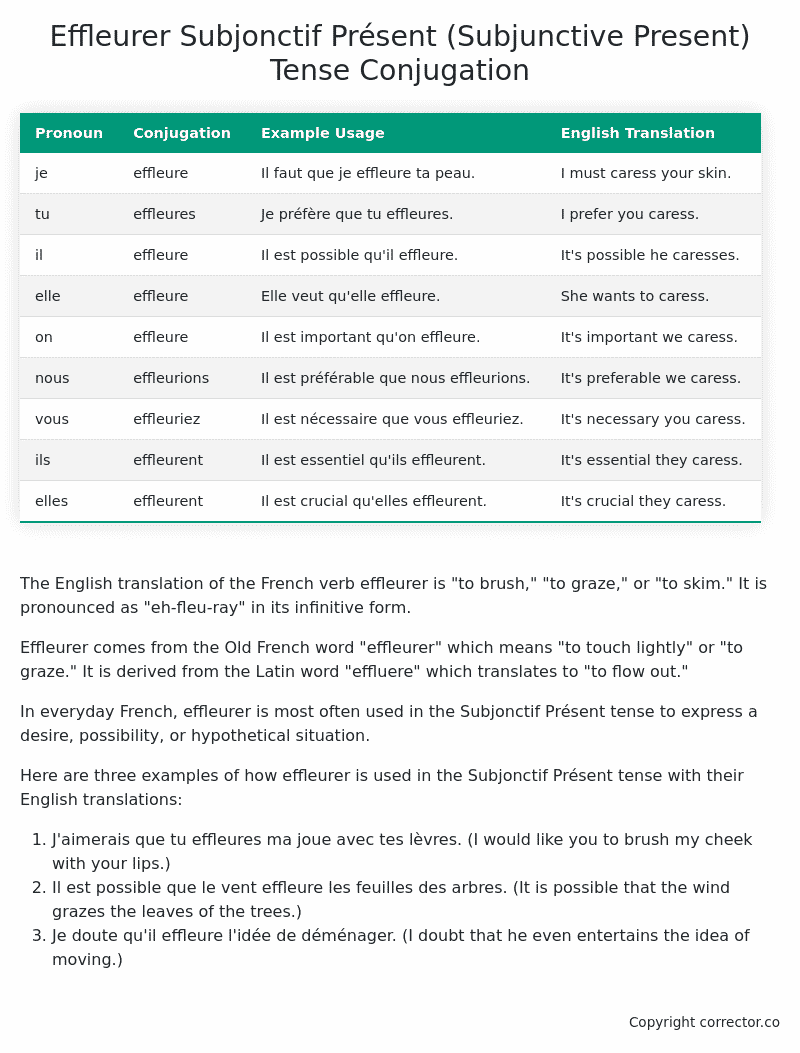Subjonctif Présent (Subjunctive Present) Tense Conjugation of the French Verb effleurer
Introduction to the verb effleurer
The English translation of the French verb effleurer is “to brush,” “to graze,” or “to skim.” It is pronounced as “eh-fleu-ray” in its infinitive form.
Effleurer comes from the Old French word “effleurer” which means “to touch lightly” or “to graze.” It is derived from the Latin word “effluere” which translates to “to flow out.”
In everyday French, effleurer is most often used in the Subjonctif Présent tense to express a desire, possibility, or hypothetical situation.
Here are three examples of how effleurer is used in the Subjonctif Présent tense with their English translations:
- J’aimerais que tu effleures ma joue avec tes lèvres. (I would like you to brush my cheek with your lips.)
- Il est possible que le vent effleure les feuilles des arbres. (It is possible that the wind grazes the leaves of the trees.)
- Je doute qu’il effleure l’idée de déménager. (I doubt that he even entertains the idea of moving.)
Table of the Subjonctif Présent (Subjunctive Present) Tense Conjugation of effleurer
| Pronoun | Conjugation | Example Usage | English Translation |
|---|---|---|---|
| je | effleure | Il faut que je effleure ta peau. | I must caress your skin. |
| tu | effleures | Je préfère que tu effleures. | I prefer you caress. |
| il | effleure | Il est possible qu’il effleure. | It’s possible he caresses. |
| elle | effleure | Elle veut qu’elle effleure. | She wants to caress. |
| on | effleure | Il est important qu’on effleure. | It’s important we caress. |
| nous | effleurions | Il est préférable que nous effleurions. | It’s preferable we caress. |
| vous | effleuriez | Il est nécessaire que vous effleuriez. | It’s necessary you caress. |
| ils | effleurent | Il est essentiel qu’ils effleurent. | It’s essential they caress. |
| elles | effleurent | Il est crucial qu’elles effleurent. | It’s crucial they caress. |
Other Conjugations for Effleurer.
Le Present (Present Tense) Conjugation of the French Verb effleurer
Imparfait (Imperfect) Tense Conjugation of the French Verb effleurer
Passé Simple (Simple Past) Tense Conjugation of the French Verb effleurer
Passé Composé (Present Perfect) Tense Conjugation of the French Verb effleurer
Futur Simple (Simple Future) Tense Conjugation of the French Verb effleurer
Futur Proche (Near Future) Tense Conjugation of the French Verb effleurer
Plus-que-parfait (Pluperfect) Tense Conjugation of the French Verb effleurer
Passé Antérieur (Past Anterior) Tense Conjugation of the French Verb effleurer
Futur Antérieur (Future Anterior) Tense Conjugation of the French Verb effleurer
Subjonctif Présent (Subjunctive Present) Tense Conjugation of the French Verb effleurer (this article)
Subjonctif Passé (Subjunctive Past) Tense Conjugation of the French Verb effleurer
Subjonctif Imparfait (Subjunctive Imperfect) Tense Conjugation of the French Verb effleurer
Subjonctif Plus-que-parfait (Subjunctive Pluperfect) Tense Conjugation of the French Verb effleurer
Conditionnel Présent (Conditional Present) Tense Conjugation of the French Verb effleurer
Conditionnel Passé (Conditional Past) Tense Conjugation of the French Verb effleurer
L’impératif Présent (Imperative Present) Tense Conjugation of the French Verb effleurer
L’infinitif Présent (Infinitive Present) Tense Conjugation of the French Verb effleurer
Struggling with French verbs or the language in general? Why not use our free French Grammar Checker – no registration required!
Get a FREE Download Study Sheet of this Conjugation 🔥
Simply right click the image below, click “save image” and get your free reference for the effleurer Subjonctif Présent tense conjugation!

Effleurer – About the French Subjonctif Présent (Subjunctive Present) Tense
Formation of the Subjonctif Présent
Common Everyday Usage Patterns
Interactions with Other Tenses
Summary
I hope you enjoyed this article on the verb effleurer. Still in a learning mood? Check out another TOTALLY random French verb conjugation!


